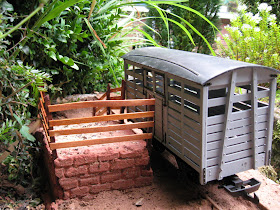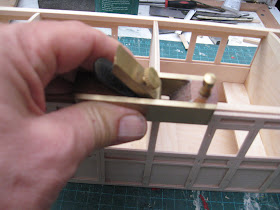So, why do we railway modellers model railways? As with most things, the rationale depends on a range of factors which lead to a variety of outcomes.
In my case, I get the greatest satisfaction from construction and from operation. Whilst I am highly appreciative of scrupulously fabricated scale models, I am more interested in something which is representational - something which will do the job and looks more or less OK.
As my fictional railway is set in a real location in the Cheshire countryside, I want the stock and buildings to be reminiscent of what might be found on a three foot narrow gauge railway at the start of the 1930s. My locos are inspired by those which were constructed and run in the British Isles.
As my modelling skills are basic, and my tolerance for inaccuracy is quite high; I am more than happy to use a commerical chassis and construct a model which resembles the original. This enables me to use the limited time I have available for modelling to produce sufficient stock for my representation of a complete narrow gauge railway system. Maybe, once I have produced all the rolling stock needed, I will start replacing some of the less convincing models with more detailed alternatives but in the meantime, I will happily run closed vans which were adapted from LGB models, open wagons from my own resin castings attached to inappropriate Hartland chassis, and coaches which are based loosely on Pickering originals.
When it comes to operation, I am very keen to run services on my railway which would not be out of place on a narrow gauge railway of the era. The timetable for passenger services is a direct copy of one written in 1923 for the Southwold Railway - a 3 foot narrow gauge railway with the same number of stations and of about the same length as my railway.
Freight is handled by one dedicated pick-up goods per day, plus at least one mixed train. This is based on the services ran on the two foot six inch gauge Welshpool and Llanfair around 1915, though all passenger trains on the W&L were billed as mixed. To make life more interesting, I assume it is a summer's market day every time I run the railway. I suppose I could try running a round the year service with seasonal timetables and freight movements to match - however, as I have very little spare time to run the railway and so, for now, I am more than happy to keep re-running the same day's services, albeit with ongoing freight movements dictated by the computer program.
As realistic operation is something of great interest to me, freight movements are generated by a computer program which I wrote myself, using a relational database called 4th Dimension (or 4D) - for more detail see Progress Report 16.
I have tried to anticipate the sorts of freight which the railway would have carried in reality, had it been built. Cheshire Cheese was produced in the locality, as was soft fruit.
As the line serves a rural community, these is regular livestock traffic and the transportation of agricultural machinery, feed and seed. There is also regular traffic in household goods and grocery for the local community which in my history includes hotels serving visitors taking the local spa waters or visiting the landmarks such as Beeston Castle.
The cheese train at Broxton Station (c1910)
As the line serves a rural community, these is regular livestock traffic and the transportation of agricultural machinery, feed and seed. There is also regular traffic in household goods and grocery for the local community which in my history includes hotels serving visitors taking the local spa waters or visiting the landmarks such as Beeston Castle.
In line with the majority of railways in this era, coal is a mainstay of goods services. In addition, the railway serves two local 'industries' - copper mines and a timber yard. In reality, the copper mines in the Peckforton Hills were never highly productive, though one geological survey in the early 1900s predicted they could become the most bountiful in the UK. Three (sometimes four) trains of ore wagons travel the line each day, transporting crushed ore and spoil from the mines to the mainline interchange sidings at Beeston Market Station. In my scenario, the ore is transported to a treatment plant at the company's sister mines at Alderley Edge whilst the spoil is taken along the coast for a land reclamation project (all quite convenient!).
All railway buildings have been (and will be) constructed from timber, grown locally as part of the Peckforton Estate's forestry enterprise and any other buildings reflect those in the locality being constructed from the local red sandstone.
One day, I will develop a signalling system. With the copper mine trains and the goods train running concurrently with the passenger services, I cannot operate with 'one loco in steam'. I'm assuming the Board of Trade would insist that the density of traffic merits an interlocked signalling system - but this is something yet to be fully researched.
So, modelling the Peckforton Railway has provided an opportunity for me to create a representation of an imagined reality - with the emphasis on 'representation'. I am happy to tolerate inaccuracies in the appearance of the models, provided they are broadly appropriate for the context.
In order to create the railway I have had to carry out historical research into the building and operation of similar railways and into the history of the locality for the line. I have surveyed the actual route to ensure the railway is feasible and investigated the copper mining process. I have developed skills in landscaping, gardening, brick laying, casting in concrete, stone masonry and joinery. I am now reasonably proficient in electrical wiring (both low voltage and mains), metal working and modelling in plastic, resin casting, woodwork and timber.
I have developed an understanding of basic mechanics and the properties of materials and joining techniques. I am getting to grips with spray painting, brush painting, lining, weathering and and distressing (the models, not me personally - well not much!). I'm also beginning to investigate fashions of the early 1930s, to ensure the little people which will populate the railway will not look out of place.
I'm not aware of any other hobby which combines so many skills and multifarious competences. It certainly keeps me occupied, and out of mischief. One day, the railway will be finished, but in the meantime, each year that passes sees yet more developments and innovations.








Spot on! This is exactly why Model Railways are such an incredible hobby in any scale - it's that combination of a whole variety of model making skills, historic research and combining it with some artistic interpretation that makes the best and most memorable railways. I'd definitely include your line in that list :)
ReplyDeleteThanks for the comment James. It is indeed difficult to think of any other hobby which entails electronics, mechanics, woodworking/joinery, metalwork, resin casting, historical enquiry, surveying, gardening, landscaping, bricklaying, concrete moulding, working in plastics, sculpting, painting and the art of weathering. Not to mention the maths of ratios and scaling.
ReplyDeleteA "Signalling System" could be lots of different things, not all involving red arms nodding up and down on white posts. For your prototype and era some form of "staff and ticket" system would be typical, although with the complexities of your layout (with parts of the model line representing 3 different prototype "sections") you might need a Mobius Staff. You wouldn't need much in the way of signals (you could get away with none at all if your loop points were locked by the staff) but if you like 'em have 'em! With my professional hat on I'd say that all the many, varied, complex rules surrounding signals can be boiled down to a few simple guidelines.
ReplyDelete1) Put a signal where you want a train to STOP. If there's no signal a train won't stop, so it's the red aspect that matters. This would mean putting the signals on the approach to any pointwork, facing (a "home" outside a passing station) or trailing ("starters" to let a train depart). The latter need to protect the "fouling point", so a train stood there isn't going to get clonked by another entering the loop in the other direction.
2) Only tell the driver what he needs to know. If you like signals it's easy to overdo it, with every possible move in every condition covered until it all gets a little overwhelming. Typical narrow gauge/ light railway practice would be to only provide a signal for a movement made by a passenger train, or running moves off passenger lines. So that cuts out shunting discs, subsidiary "calling on" arms and all sorts of fiddling around. Junction signals would only be needed where there there really are multiple directions to choose from- most passing stations have a definite "up" and "down" and only right-direction moves are signalled.
3) Make sure the driver can SEE the signals. A lot of fun can be had with this, getting your eye (or a camera) down to drivers' eye level to see if the signal they're approaching is clearly visible. Railways went to some lengths to ensure this, and there are lots of simple but interesting ideas to model: sighting boards, brackets (including underslung), banner repeaters, or even placing the signals on the "wrong side" because that puts them on the outside of a curve so improves the sighting.
Distant signals come into this too- only marginally useful for narrow gauge & light railways but they do add a welcome splash of colour. The rules said you didn't need them unless the home wasn't visible from a quarter-mile away, and also they didn't actually have to work. A non-moving "fixed distant" arm can serve as an advance warning to a driver on the approach to a terminus or crossing place, since every train has to stop there.
This comment has been removed by the author.
ReplyDelete(previous comment deleted because the link didn't work)
ReplyDeleteThanks for that detailed response, Tim. Since writing this post, I've actually instigated a signalling system - http://riksrailway.blogspot.co.uk/2014/01/how-i-constructed-19-semaphore-signals.html - but there's plenty of useful info here on where they should be sited. Because of their delicacy, I don't deploy the signals every time I run trains, but when I know I'm going to get a few days of decent weather I put them out